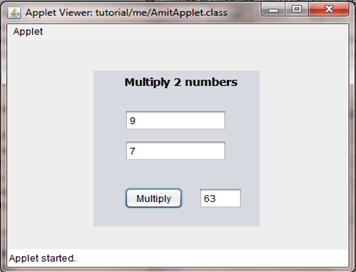

I found theĮxisting tools to be lacking, and realized that it was fairly easy for Suitable for looking at large alignments of lots of genes.
#APPLET VIEWER DOWNLOAD HOW TO#
The purpose of this example is to demonstrate how to view sequenceĪlignments with java treeview. Open in Java TreeView, click on Analysis->Alignment.

Moving the mouse over the image should now indicate the position of each locus in bases from the centromere fractional positions can result if the orf has an odd number of bases, as I just averaged start and stop. The karyoscope should redraw, as the genes shift around a little. This should pop up a file dialog navigate to "Treeview/coordinates" (whereever you installed treeview) and select "YeastCoordinates.pcl". To set coordinate, click on the "Coordinates." button in the upper left panel of the karyoscope display. For purposes of illustration, let's use a real coordinates file to view this yeast data. In the abscence of a coordinates file, java treeview can guess where to put yeast genes using the YORF column. I have included coordinate files for human and yeast stanford arrays, and I am willing to help construct such files for other organisms/arrays. The easiest way to do this is to set up a coordinates file for each set of gene ids. A karyoscope display should now appear.īut how to do this with non-yeast datasets? As detailed in the manual, Java Treeview needs to know the coordinates of every gene id in order to display the ratio in the correct part of the karyoscope. If you do not, it will open in classic mode and you won't be able to make the karyoscope plot.
#APPLET VIEWER DOWNLOAD DOWNLOAD#
To recreate and browse this view on your own computer, download the pcl file above, and BE CAREFUL TO SELECT LINKED when you open it in java treeview. There are also a lot of visualization options, including color customization and whether or not to draw lines between the tips of the bars. What is not obvious from the image is the way that java treeview lets you rapidly zoom in on different parts of the image to find out what genes are present at the breakpoints, and what the enrichment ratios are. Clearly visible is an amplification of the left arm of chromosome 14, and a deletion of the right arm. This example of a karyoscope was made using data from Proc Natl Acad Sci USA 2002 Dec 10:99(25):16144-9, "Characteristic Genome Rearrangements in Experimental Evolution of Saccharomyces cerevisiae.". In the the image shown, a compelling cluster selected in the dendrogram is revealed to be a spot artifact, since nearly all spots in the cluster come from the same spots in the same location on the array (adjacent spot numbers are located in the same sector on Stanford arrays). Selecting genes in the dendrogram will cause the corresponding spots in the scatterplot to be selected. You should be confronted with a plot similar to the above. Open in Java TreeView, click on "Analysis->Make Scatterplot." then select SPOT for the Y-axis and leave INDEX as the X-axis and click "Go!". A more mature version may one day make it into the helper-scripts package. You can use it as a starting point for your own script. Special bonus: the perl script which I used to do the coloring: With genes which I haven't made a screenshot of. I also have an older example set of files which show how to associate colors Open the cdt file in excel to see how it works. In practice, you would want the colors to represent some kind of biological information here, I just did something random with excel. This garish image demonstrates how you can independantly control the background and foreground colors for genes and arrays using BGCOLOR and FGCOLOR rows and columns. Your browser is completely ignoring the tag! A subset of Paul Spellman's cell cycle data was hierarchicallyĬlustered and used with the applet distribution. Dendrogram Coloring By Correlation Threshold Example.Note that the applet distribution can be built from the source using the "applet" ant target. Please use the "View Source" feature of your browser to inspect the relevant applet tags.Īll of the following examples use the TreeView-1.1.0-applet distribution, which should be available They demonstrate how one can use the different plugins with the applet version of Java Treeview. These example applets display the same files as the application examples.


 0 kommentar(er)
0 kommentar(er)
